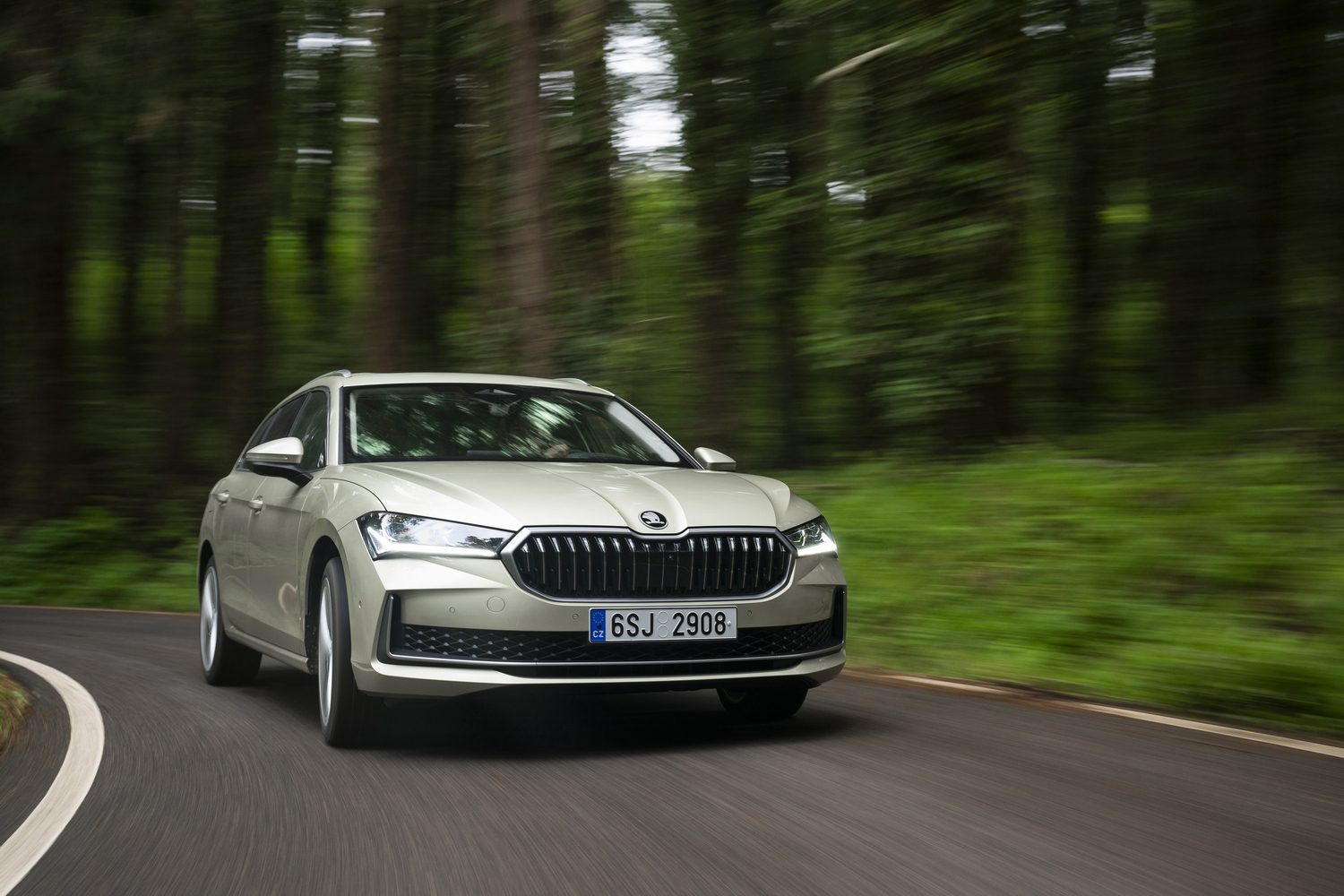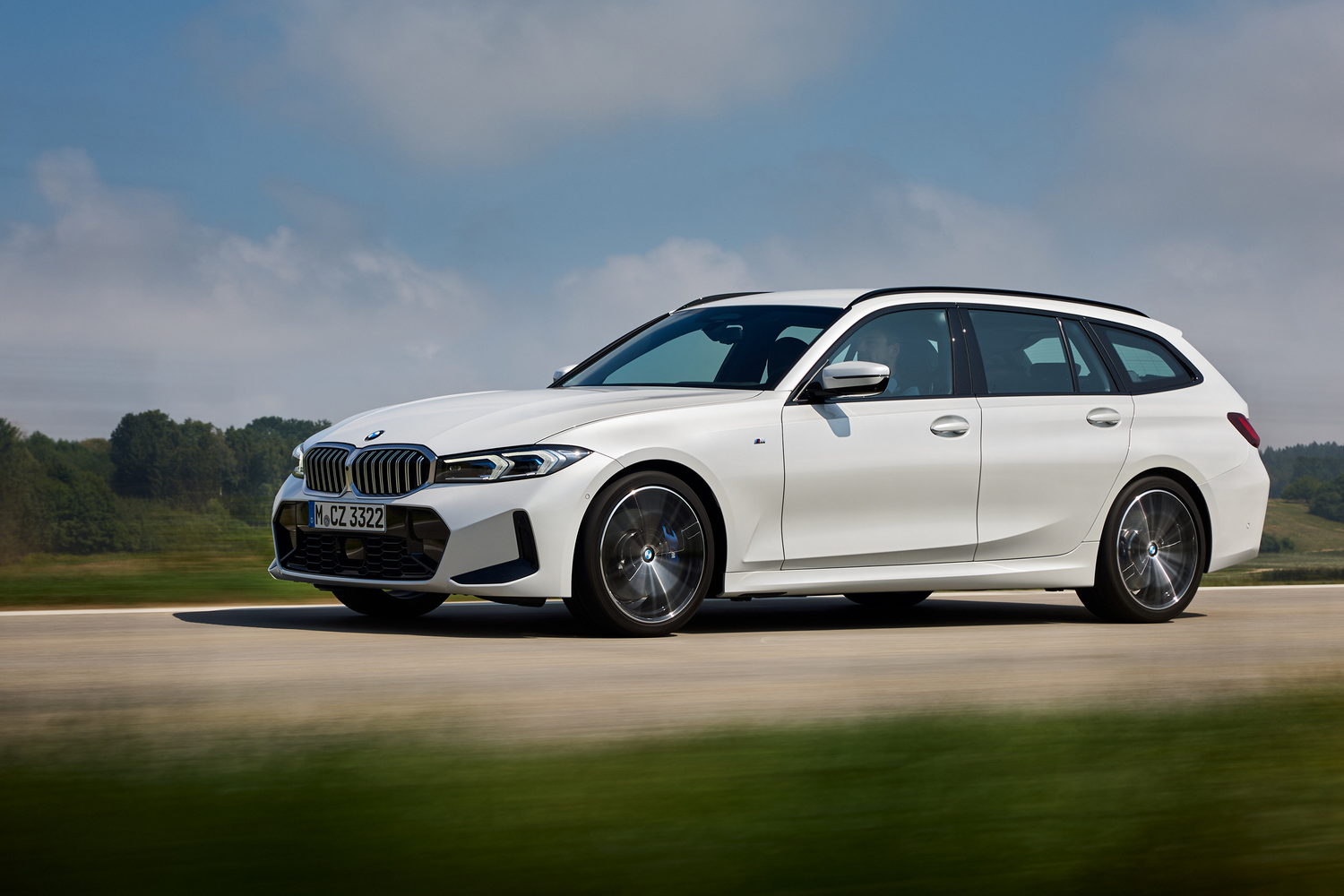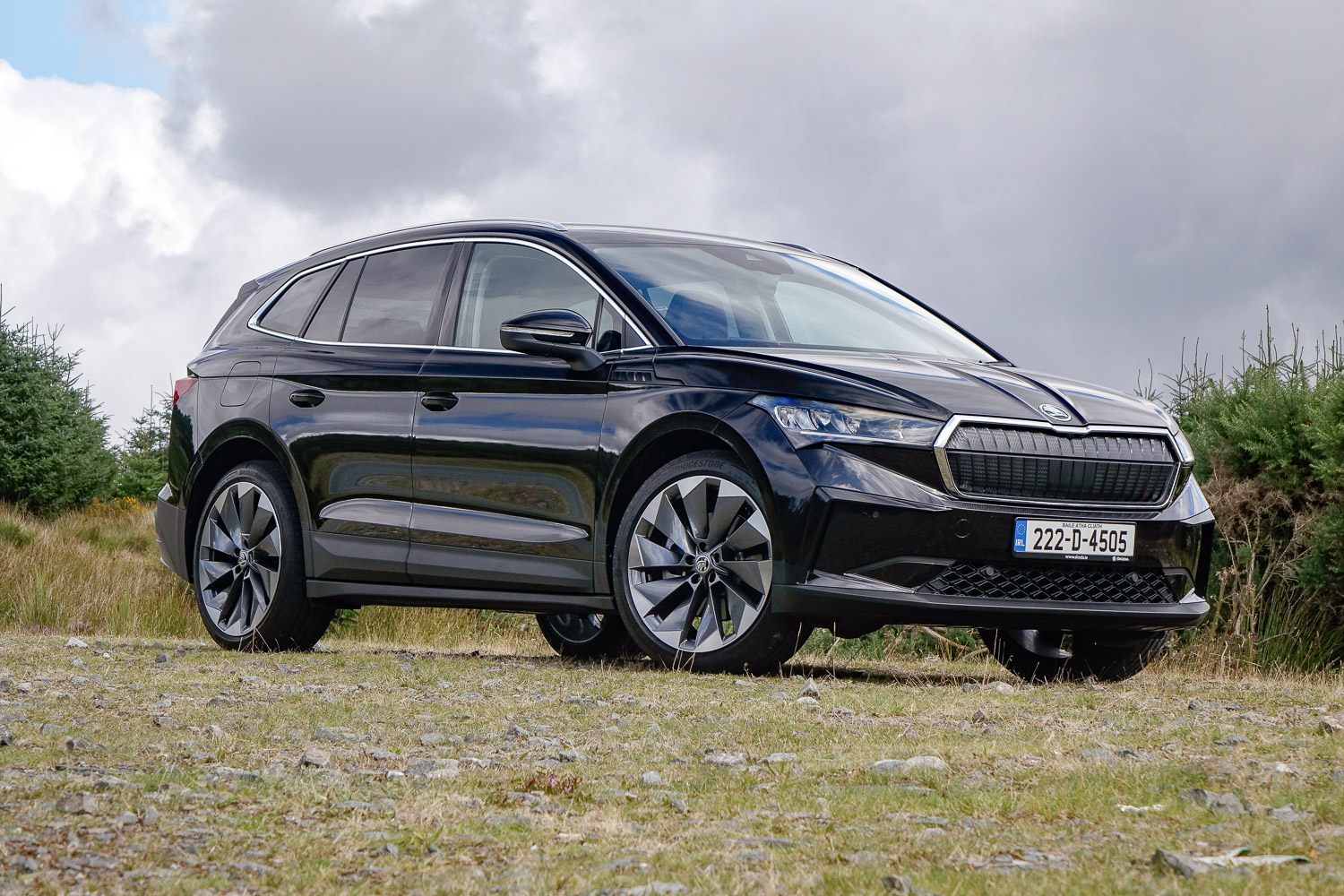Skoda already made what was the best large family estate car in the form of the Mk3 Superb Combi, but for the all-new model the Czech company has smoothed off the looks, improved the interior quality, added more range to its hybrids and given the Combi an even more colossal boot. The result is that the best just got that tiny bit better still.
In the metal
Deciding not to throw the aesthetic baby out with the design bathwater, Skoda has hardly 'started again' with the look of the new Superb Combi, instead tidying and polishing what went before. It's a cleaner, crisper - if familiar - shape overall, dominated by a large octagonal radiator grille and one-piece LED headlight/indicator units that have an optional Matrix specification (in that they can dip certain parts of their illumination field to prevent dazzling other road users) with 'Crystallinium' design elements therein.

It's less distinctive at the rear than it once was, though, with the new, sleeker lamp units for some reason making us think of the old Opel Insignia Sports Tourer - nevertheless, the overall effect of the Superb Combi's styling is of something smooth and elegant, and effortlessly handsome too.
Like many a modern car, the Superb Combi has grown, although not significantly - it is 40mm longer and 5mm taller, yet also 15mm narrower than previously. The space between the axles (the wheelbase) has not changed, however, at 2,841mm, yet Skoda is claiming more headroom in both the front (+7mm) and back (+8mm) of the car, while one of the Superb Combi's strongest selling points has become even more impressive: boot space is up 30 litres with all five seats in play, resulting in a whopping 690-litre figure. And despite all this added practicality, the car is 15 per cent more aerodynamic than it was before, resulting in a coefficient of drag of just 0.25.
In practice, all these tweaks work. This is a simply vast car on the inside, with rear-seat passengers benefitting from legroom so voluminous it's almost embarrassing. The cargo area is every bit as enormous as you expect of a Superb Combi, while the passenger compartment is riddled with loads of Skoda's 'Simply Clever' touches - one particularly neat feature is the tablet holder integrated into the rear armrest, which also forms the cover for the cupholders back there.

Both material quality and the aesthetic design of the main front area of the Skoda's interior rank highly in our opinion, but they are not without some quibbles. So while we really like the way the 'Smart Dials' work (those three round knobs that control climate functions and other switchable parameters, such as the drive modes, meaning physical switchgear for key aspects of the Superb's make-up remains and therefore not everything is 'on the screen') they can feel a bit flimsy in terms of the plastic used on them, while the central command dial stopped working for a period on the launch after we jabbed it a few too many times in succession; it only returned to life when we stopped and re-started the car. Also, the dials wobble about a bit if you're too heavy-handed with them.
Furthermore, clearly the biggest annoyance for most people is the way the ten-inch digital instrument cluster has been integrated into the dash... or should we say, hasn't been integrated? It is a rectangular screen sitting beneath a curved cowl atop the dashboard, with the upper corners of the display jutting out to the sides of this. Plenty who have seen pics of it have complained about the way it is presented, so it may well bother you. We must confess that, beyond commenting on its clunkiness the first time we got into the car, we soon forgot about it.

There are more nitpicks, such as what you think of the 'Hannibal Lecter's face-grille' central dashboard trim, but we're really digging for stuff here because the Superb's interior is, well, superb. It's big, it's well-built, there's loads of equipment and practicality mixed in, everything works in a sensible and intuitive fashion, including the 13-inch main infotainment display (that's the optional one, as a 10.4-inch item is standard) and the digital instruments, which are almost bypassed if you get the excellent (if optional) head-up display. It feels like a thoroughly high-quality place to have to spend some time. So, from an aesthetic point of view, inside and out, the Superb Combi is off to a strong start.
Driving it
Skoda has launched this generation of Superb with an array of TSI petrol, TDI diesel and iV plug-in hybrid (PHEV) drivetrains, although the Czech outfit is moving away from the 'iV' nomenclature, so we'll just refer to the part-electric Superb Combi as the PHEV from now on. Every model has a DSG twin-clutch automatic gearbox (there are no manual Superbs any longer) which has either six speeds (the PHEV) or seven (everything else), with drive going to the front wheels only in the main across the range. There are a couple of higher-powered TSI (265hp) and TDI (193hp) units offered which have four-wheel drive, but we're focusing on the front-drive cars here.

The 150hp TSI petrol Skoda now uses mild-hybrid technology and, having tried it, there's no doubt it's a fine companion for the Superb Combi. It has ample power and torque to make progress in traffic easy, while it's smooth enough and quiet enough (below 4,000rpm) to make it an excellent choice for those wanting an uncomplicated ownership experience. That said, it gets a bit raucous when revved out, it doesn't provide the greatest fuel-economy returns and, while we did say that it has enough torque to get about the place, with 250Nm it can occasionally feel as if it wouldn't hurt to have another 50Nm on your side. Like, if you ever need to overtake anything on a two-lane road.
There's also a significantly enhanced PHEV model, producing up to 204hp and a big enough battery to be able to do more than 100km on electric power alone - according to the official figures. It now has DC-charging capabilities this time around too and there's a full report on that car elsewhere on our website.
Which leaves the TDI, an unfashionable choice today. As we said, there's a 193hp variant of this 2.0-litre, four-cylinder turbocharged unit available in the Superb with all-wheel drive, but of far more importance is the 150hp front-wheel-drive model, which is what we're driving here.
And it is, in this specification, utterly brilliant to drive. The Skoda Superb Combi TDI is one of those relaxing, easy-going cars that makes you want to scream 'don't just go out and buy an SUV without thinking about things carefully first', because it is a joy to travel in. First disclosure: every Superb we tried on the launch was fitted with Dynamic Chassis Control (DCC) adaptive dampers and while we await final Irish specifications to see what's standard, we haven't yet tried a Superb Combi with the fixed-rate shock absorbers.

But if the DCC-equipped TDI is anything to go by, you won't get anything that can travel in a more comfortable fashion than the Skoda this side of a Bentley. It's a dream. The isolation of potential mechanical intruders to the cabin's peace and solitude (tyre noise, wind noise, engine noise, suspension noise) is nigh-on absolute, so that even at a 120km/h motorway cruise, you can conduct a conversation with your passengers at a whisper, if you want, and we can guarantee what you're saying will be audible. Even to hard-of-hearing people sitting half-a-mile behind you in the second row of seats.
Complementing the hushed passenger compartment is that ultra-plush DCC suspension. It can feel a little lumpen in Normal mode but slot the car into its pre-specified Comfort setting - or, better still, use the Individual mode to configure the dampers right down to softness level 1/15 - and the Skoda floats along. It flattens almost every road surface into something akin to freshly laid tarmac, while there's a wonderful, serene - yet always controlled - squidge to the body's movements in the wake of large compressions that just melts said disturbances into nothingness.
Where it has moved the game on from the model it replaces is in the handling stakes. Now, we're not saying the Combi TDI is a thrill-a-minute machine in the corners, because it isn't. Yet there seems to be an added tautness to the body control in the Sport setting, as well as a sense of extra heft from the (generally) light, pleasant and accurate steering, that makes the big estate feel a tad more limber. Ask really serious questions of its chassis hardware and it does start to expose the size and primary remit of the car, as the rear axle can sometimes respond in a manner resembling surprise at what it's being asked to do - especially if it meets a bump mid-bend with the front tyres loaded up to a significant degree. But in general, the Superb Combi has road-holding abilities which are a welcome bonus on top of its thoroughly exemplary ride quality and rolling refinement.
And that leaves us with the diesel engine itself, which is a gem. The 110Nm of extra torque it has makes all the difference in the world compared to the 1.5 TSI unit, so while their maximum power outputs are no different, the diesel feels more muscular and impactful from low revs. There's a small degree of lag to its delivery, but overall once it's spooled up it's a far better match for the Skoda's sizeable body than the TSI petrol.

It also sounds remarkably quiet outside at idle, and inside up to about 4,000rpm - and even when you can hear the diesel's exertions, it's a less strained racket than the petrol mild-hybrid's. The final cherry on the cake here is that we saw 6.1 litres/100km across a varied 110km test route in which the car was not driven in a manner which was anything like its most economical; the petrol alternative wouldn't get near that, no matter how efficient you drove it.
What you get for your money
Skoda Ireland has confirmed the 1.5-litre TSI MHEV and this 2.0-litre TDI 150hp as the two engine choices to kick things off for the Superb, with possibly more models - including the plug-in hybrid - still to come. Specifications run Selection, Selection + (Plus) and then high-ranking L&K, with the fastback 1.5 TSI kicking off at €48,325 in the first of these, €50,825 as a Plus and then topping out at €57,485 as the opulent L&K. The TDI is around €500 more spec-for-spec again, while the Combi estate is €2,000 extra compared to its equivalent fastback: this means the 2.0 TDI Combi starts at €50,825 and rises to a peak of €60,295, the L&K being the only model in the 12-strong Superb launch line-up that’s beyond the 60-grand marker.
Those prices, we feel, represent a bargain for the sheer quality of car you’re getting, and they’re not a million miles away from the old model’s bracket of €40,975-€56,350. You also get plenty of equipment for your money, with an extensive safety and advanced driver assist roster on the basic Selection bolstered by pleasantries such as adaptive cruise control, keyless start/stop, the 10.4-inch infotainment system with wireless Apple CarPlay and Android Auto, wireless smartphone charging, three-zone climate control, a nine-speaker sound system, front and rear parking sensors with a reversing camera, a powered tailgate with ‘Virtual Pedal’ motion sensor, an auto-dimming rear-view mirror, the 10.25-inch digital driver display, heated front seats with a basic pneumatic massage function, 18-inch alloy wheels, LED headlights, taillights and daytime running lights, heated and electric exterior mirrors, rear privacy glass and an external chrome pack for the detailing, among much more.
Selection + adds leather upholstery plus ergonomically certified front seats with an advanced massage system, electrical adjustment, memory functionality and ventilation to go with their heater elements, as well as interior ambient lighting. L&K really loads in the luxuries, such as 19-inch alloys, full Matrix LED headlights with washers, dynamic indicators for the rear lamp clusters, the larger 13-inch infotainment system, L&K-specific interior details (such as stitching and logos on the seats) and exterior brightwork and badging, Dynamic Chassis Control, drive mode select, heated seats in the rear, and a 12-speaker Canton sound system with a subwoofer.
Finally, in terms of one of the fixed running costs, the 1.5 petrol MHEV is €10 a year cheaper to tax than the 2.0 TDI, at €200.
Summary

No major changes have occurred for the new Skoda Superb Combi, but what has been altered has enhanced what was already a deeply compelling package. Fitted with the 150hp TDI diesel engine and the DCC suspension, this goes straight in as one of our cars of the year already - it's a truly brilliant, eminently likeable and deeply desirable bit of kit.




























